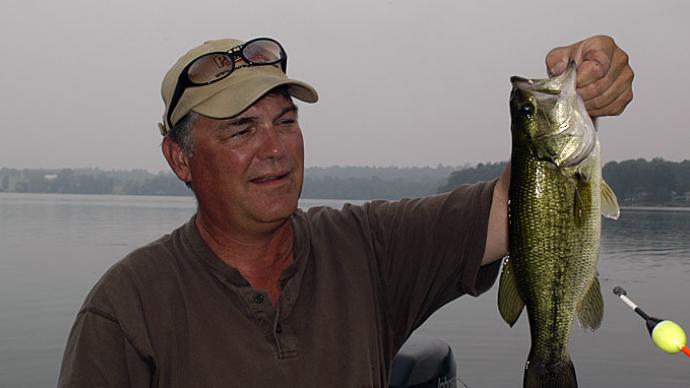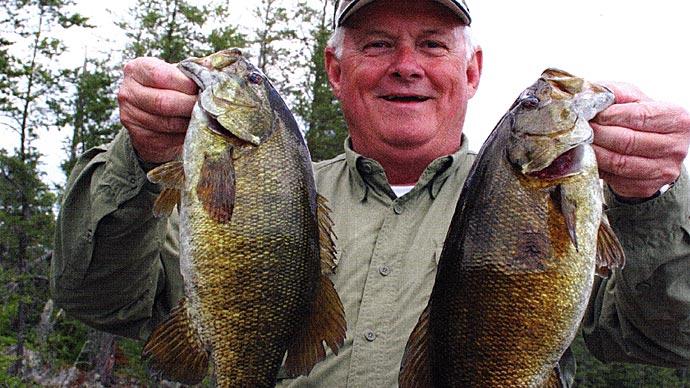
Stillhouse Hollow (Texas) is a beautiful lake. Tucked into a landscape of undeveloped limestone hills and low juniper-oak clusters, its emerald-blue water is clear and inviting. Like Lake Whitney, Stillhouse Hollow holds some fine smallmouth bass, but Mike Hastings and I came for a different reason this summer day.
Donning my PFD and settling in for the short boat ride, Mike began to chatter. His enthusiasm could not be contained, "Man, the largemouth bass have been schooling on Stillhouse for weeks. Every day, at about 9:00 a.m., regular as an alarm clock, they will boil the water. The fish are getting smaller, but there are millions of them. It's finicky, though, hard to get a bite. That fly rod of yours might be just the ticket. I am going to use my "launcher."
By any measure, Mike Hastings is one of the finest fishermen I have ever met. Meticulous in rigging his tackle, creative in his bait selection, and capable of consistent pinpoint casting accuracy, he always catches fish. His topwater fishing technique is superb. His boat is cleaner than my house. I had always enjoyed complete confidence in his judgment. And then he showed me his invention, "the launcher."
"This thing works great. It is a nine-foot rod with a weighted cork, a four-foot leader, and a small shad-colored lure at the end. I can cast it a long way.
Mike made his first cast of the day, winding up as if to throw a Nolan Ryan fastball. I never saw the bait hit the water, though I am sure it came down somewhere in Bell County.
"Geez, Mike, not much of a cast," I said in mock disbelief. "is that the best you can do?"
"No, I'm just not warmed up yet. Sometimes, I can get it out there 80 yards or better."
"You gotta' be joking." "Nope, the secret to this technique is casting the bait a long distance and keeping it running very shallow. These schooling bass are chasing the shad right up to the surface. If you cast into the school, it spooks them, and you can't get a bite. But with this rod and tackle arrangement, I can cast a tiny bait for a long distance and keep it right at the surface during the retrieve. I am telling you, the fish are finicky, and this thing works."
My gear for the day was a nine-foot, nine-line-weight fly rod with a weight-forward floating fly line. A good cast for me with this gear might be 40 feet, much less 80 yards.
But the principle of lure presentation was the same. With a fly line, I could drop a shad-colored fly onto the surface of the water with barely a ripple and retrieve it just below the surface. We would have to get reasonably close to any schooling fish we might encounter, but Mike assured me that would not be a problem. "They will be jumping in the boat."
We took a short run out to Mike's fishing grounds, taking a few practice casts and scanning the surface for action. The crystal clear water lacked the slightest ripple, as the day promised to be windless and hot. The launcher almost immediately yielded a small bass, a second, and a third. My fly line had been stretched once by the time he boated his fifth fish. But at 9:15, Central Hastings Time, the water in the distance became frothy with schooling bass.
"Show time," Mike grinned as he fired up the motor and moved into position.
Within minutes, we were both hooked up. The surface of Stillhouse Hollow seemed to be carpeted with small shad, and the bass were in such a frenzy as to leap sideways into the air in pursuit. I hooked a fish on almost every cast as the shad fly lured the hungry bass into range and the boat. Within the first hour, Mike and I boated more than 15 bass.
Launching his cork and leader into the distance, he would retrieve his fly just under the surface, holding up on almost every cast. Laying the lightweight fly line onto the water and pausing to let the fly sink a few inches, I would begin to strip the line toward me. Bass after bass took the bait.
As is almost always the case when fishermen begin to catch fish, other fishermen move into position near us. One boat, then two, circled our position, and in short order, Mike and I were in the middle of a metal-flake flotilla. Six bass boats had eased into position near us, each casting into the same groups of feeding bass we enjoyed - with one remarkable difference. They were not catching any fish. I mean none. Perfect cast after cast fell into the water with not a single fish being boated by 11 other fishermen.
"I told you they were finicky," Mike said, releasing another fish. "You gotta' have just the right bait and just the right size."
"Hey Mike, what are you using," called one of his friends. 'We can't get a bite to save our lives."
"That is one of my friends from Bastrop," he told me. "I'm using a launcher with a shad-colored grub," he yelled in return. "He is using a fly rod."
Two other fishermen eased close to us, and I handed each a couple of my flies. "These are too small to cast with this rod and reel," one of the anglers noted as he returned them and leaned back with a sigh of resignation.
Over the next few hours, Mike and I caught 51 largemouth bass and one smallmouth. Mike's launcher had accounted for 27 fish, and my fly rod had snared the remaining 24. Total number of fish caught in six other boats: two. Four of the other boats had finally left in frustration, and as he fired up his motor to leave, we heard Mike's friend from Bastrop say, "There is something wrong when one fly rod catches more fish than six bass boats."
In a sense, he was right. It is unusual for an angler with a fly rod to enjoy greater success than a counterpart using baitcasting or spincasting and more efficient means of fishing, and this strategy allows the angler to use more extensive and more diverse types of lures. But on some occasions, fly rods can be deadly.
The success that Mike and I enjoyed on Stillhouse Hollow that day was a perfect example of the importance of presentation. These fish, feeding on small shad at the surface, were easily spooked by larger lures striking the surface, and the weight of the lure was taking it out of the feeding zone. We witnessed spinnerbaits, spoons, jerkbaits, and topwater lures - almost everything one could imagine - being tossed into the schools of bass with no success. Yet the small flies we employed, almost perfect shad imitations, were attacked with ferocity.
Secondarily, Mike's strategy of casting over the school and retrieving a fly held at the surface by a weighted float had the same effect as my floating fly line. Neither spooked the fish, and both flies were suspended near the surface.
I must admit that I did not start fly fishing until I was well into my 40s (closer to 50) because I thought it would be too hard to learn, expensive, and "elitist." After all, I was a real bass fisherman, weaned on WD-40 and the smell of diesel fuel. I still have my first open-face baitcasting reel. And I still use it. But I could not have been more wrong, and I think that every bass angler could enjoy success by adding a fly rod to the quiver.
A seven-weight rod with a matching fly line is perfect for throwing all sorts of bass bugs, minnow imitations, and sinking flies.
Learning to cast a fly line is infinitely easier than a baitcasting reel. An hour with a good fly caster can turn the most seasoned baitcaster into a successful, if not silky, fly caster. All of the knots used in baitcasting are immediately transferable to splicing fly lines and leaders.
While many fly rods and reels are very expensive, excellent rods and reels can be had for about the same price as a high-quality baitcasting rod and reel. My favorite bass fly rod and fly reel cost less than $200, and flies like those Mike and I used are about $2.00.
After Mike and I returned to Austin, I drove downtown to the Austin Angler and bought every shad imitation fly Larry Sunderland had to sell. I returned to Stillhouse Hollow the following Sunday, paddled my kayak a mile or so out to the area where the bass were schooling, and caught another 25 bass amid bass boats and more frustrated anglers.
Just some tree-hugging, Austin nut paddling a kayak, and using a fly rod. But that day, I sold every fly I had to my fellow fisherman for $1.00 more than I had paid for them two days before. Who would have thought fly fishing could be so much fun and profitable?
Catch and release.




